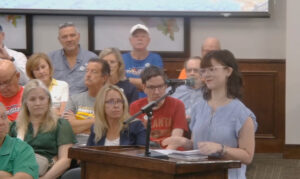The Peachtree City Council learned Thursday that the structural problems with the Lake Peachtree spillway extend further than the human eye can see.
That’s why engineers lowered a special high-definition camera under the surface to “get to the bottom” of the problem.
Down below is a cavern-like environment that has been created by erosion, endangering the spillway to the point where the lake has to remain low until the structure can be repaired or replaced.
Unfortunately, the lake is likely to remain that way through at least the summer if not considerably longer.
There is no concrete start date for the repairs at this point, as county officials can’t proceed with a design until they get a blessing from the state. The Georgia Safe Dams program is evaluating the potential hazard to downstream properties if the dam or spillway were to fail.
That decision, expected by the end of this month at the earliest, is crucial because it will play a factor in the extent of the repairs, according to Fayette County Administrator Steve Rapson.
If the state classifies the lake, dam and spillway as one that could “endanger human life downstream” if breached, the county may appeal that decision due to the potential significant increase in repair costs … thus further delaying the spillway repair and eventual refilling of the lake.
While the county has been working behind the scenes, including the modeling of what could happen if a dam breach occurred — the city council has decided to hire a special attorney to handle the matter on its behalf as council continues to get an earful from residents displeased with the unsightly lake bed, a far cry from the lake’s usual pastoral charm.
Council appointed attorney Andrew Welch of McDonough, who gave a brief presentation at Thursday’s council meeting. At his recommendation, council voted unanimously to send a letter to the county outlining the city’s expectation that the lake be refilled as soon as possible.
Councilman Eric Imker expressed frustration that the issue has dragged on so long, arguing that the county should be drawing up plans for the more expensive repairs right away without waiting to see what EPD’s decision will be. Imker said he didn’t care about the cost, but he is also presuming that the county water system will foot the entire bill, which at this point remains to be seen — and is likely another reason council decided to hire an attorney for this particular issue.
Under a 1966 agreement updated in 1985, the county is required to maintain the dam and spillway through the year 2034 since it is using the lake as a water reservoir. However, Rapson has indicated the county will evaluate whether it even needs to pull water from the lake anymore.
It’s not immediately clear whether shutting off the spigot would absolve the county of its spillway and dam repair responsibility.
The Citizen learned this week that the county is looking to speed up the lake dredging process so it can be done while the lake level is low, particularly since there is no answer likely on the spillway repair process for at least another month.
By the end of July, the county expects to have its emergency action plan for the repairs, assuming there are no further delays.
The mostly dry yet mucky lakebed has been a sore sight for residents’ eyes far longer than anticipated when it was drained in January for what was thought to be just two months. The muck has also been a source of amusement for some, as children have played in the dirt and adults have driven their vehicles on the lake bed, only to get stuck in the mud, receiving an obligatory citation from the police department for improper use of the lake.
The underground video camera feed from beneath the spillway, played for the city council Thursday night, showed a cavern-like environment. The spillway is designed to help prevent a potential dam breach which would cause significant flooding downstream.
Because that void increased the potential for the spillway to fail, the county has kept the lake level low while the matter is investigated, city Community Services Director Jon Rorie said.
The county uses the lake as a source of raw drinking water through an agreement with the city, as the city owns the lake.
The county is waiting to hear back from state regulators as to whether the lake’s dam and spillway are rated as a “category 1” or “category 2” hazard. If determined to be a category 1 rating, the repairs are expected to be far more expensive than if the lake is deemed a category 2 by the state.










Leave a Comment
You must be logged in to post a comment.